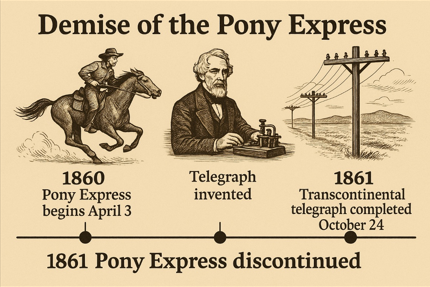The Weekly Reflektion 24/2025
The development, introduction and adoption of new technology can have a significant effect on business and business ventures. Sometimes this effect can improve a business significantly, and other times the business becomes no longer viable. Some business leaders are not looking for and anticipating new technology and they could pay a high price for their lack of curiosity. Other business leaders see all sorts of opportunities when the new technology arrives.

Are you actively looking for what technology might be round the corner?
As the United States expanded westward, the distances between cities increased significantly. There was a recognition of a need for faster communication. In the spirit of an alleged future quote from Henry Ford, some people saw the need for faster horses.
The ‘Pony Express’ was a fast mail service that operated from April 3, 1860, to October 24, 1861. It was run by the Central Overland California and Pikes Peak Express Company and connected St. Joseph, Missouri, to Sacramento, California covering about 1,900 miles. Riders would relay mail on horseback across rugged terrain, completing the route in about 10 days, which was incredibly fast for the time.
The telegraph, invented by Samuel Morse and developed through the 1840s, allowed messages to be sent almost instantly over wires using Morse code. However, the telegraph lines hadn’t yet been connected coast-to-coast in the early 1860s, which is why the ‘Pony Express’ was briefly vital. The completion of the transcontinental telegraph on October 24, 1861, was the final blow to the ‘Pony Express’. The line linked the East Coast to California, making physical mail delivery over long distances significantly slower and more expensive by comparison.
The founders of the company were experienced freight and stagecoach operators, not naive entrepreneurs, and they were aware of emerging communication technology. The telegraph predated the Pony Express by at least 16 years; Samuel Morse had sent the first message in 1844. By 1860, telegraph lines had already reached much of the Eastern U.S., but there was still no coast-to-coast connection. That’s the gap the Pony Express filled. The owners knew therefore that once the transcontinental telegraph line was completed, their service would become obsolete. In company correspondence and historical analysis (like Christopher Corbett’s Orphans Preferred), it’s clear the founders viewed the telegraph as an imminent threat and had hoped to profit in the narrow window before its completion. The Pacific Telegraph Act of 1860, which funded the transcontinental line, was public knowledge. It was signed into law the same year the ‘Pony Express’ started. The ‘Pony Express’ was never intended to be long-term. It was more of a stopgap solution and publicity stunt to secure a government mail contract and keep the Central Overland route relevant. In fact, the company was already in financial trouble when the ‘Pony Express’was launched, and it was never profitable.
It should be noted that there is no evidence that Henry Ford actually said, ‘If I had asked people what they wanted, they would have said faster horses.’ It follows then that Ford was not then inspired by the demise of the ‘Pony Express’. While short-lived and ultimately a financial failure, the Pony Express remains a celebrated part of American history and folklore, representing daring, innovation, and the rapid pace of 19th-century technological change. Myths can of course enhance any story, and as we emphasize in our Reflektions, a good story is an important way to get your message across.
